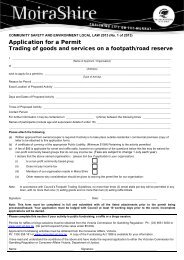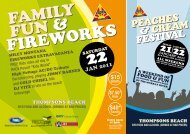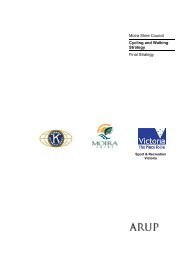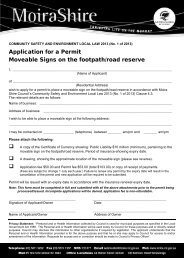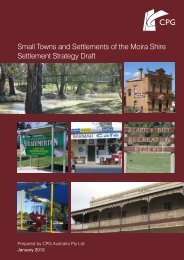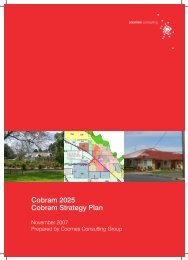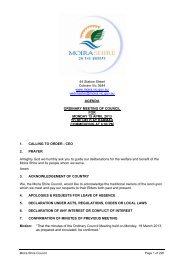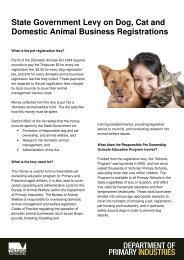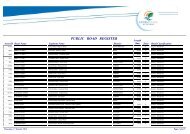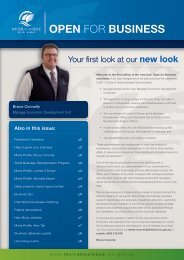Bundalong - Moira Shire Council
Bundalong - Moira Shire Council
Bundalong - Moira Shire Council
- No tags were found...
You also want an ePaper? Increase the reach of your titles
YUMPU automatically turns print PDFs into web optimized ePapers that Google loves.
4.1.3 Walking and CyclingConsultation and analysis has shown that walking isthe most popular recreational activity across all agesand genders in the area. There are many recreationalpursuits that are undertaken at the foreshore andwith the possible provision of additional trail types,management of trail use is required to avoid conflictbetween users and activities. Providing a variation oftrail types creates a diversity of experiences for therecreation user and a range of recreational user groups.At present there is one formed path (shared trail) fromYarrawonga Foreshore to Chinamans Island.People also walk along the grassy foreshore ofWoodlands and <strong>Bundalong</strong> where there are no madepaths, and make use of nearby roads for cycling.There is a compacted gravel path path along sectionsof the Murray Valley Highway between Yarrawonga and<strong>Bundalong</strong>, though relatively small numbers of peopleuse these due to the noise, fumes and perceived safetyissues from passing vehicles.This lack of clearly defined trail routes and formed pathslimits the use of the foreshore for cycling and walking,concentrates recreational walking in one area of theforeshore, and can cause conflict and safety concernsbetween cyclists and pedestrians.Generally speaking, trail routes arranged in circuitsconnecting activity nodes (i.e. there is no requirementon a user to retrace their route) are convenient andencourage people to run, walk or cycle for exercise.Circuits can be designed to interconnect and providedifferent experiences, ranging from a visit to the localplayground to day-trip cycling expeditions.There is a variable width of public land along the lakeedge. In some areas the public corridor is very narrowand private infrastructure has been built over or adjacentto public land. This discourages public access alongthe foreshore.Goulburn-Murray Water have commenced a liaisonprogram with private landowners to address theseissues, and it is recommended that this be continued.There are opportunities to provide a boardwalk alongareas of the foreshore edge where an on-land path isunable to be provided. The limited number of publicopen spaces in Yarrawonga generally puts the foreshorein high demand as a destination for local recreationpursuits. Easy access to the foreshore from residentialareas is desirable.The width of the foreshore and current delineation ofpublic and private land, makes public access along theforeshore difficult in some areas. Greater access, whilerespecting residential privacy, must be addressed.For some activities such as cycling where distancestravelled may be greater than other trail based activities,access need not be formally provided at the watersedge, or in the foreshore reserve at all. Rather, offroadtrail routes can be directed through a variety ofdifferent landscape settings types, in adjacent parklandincluding along the adjacent road verge, and at differentdistances from the water.The StrategyDemand Management StrategyAccommodate a variety of paths to and along theforeshore, to minimize conflict between cyclists andother trail users:––––––Locate the shared pathway along theforeshore edge where appropriate.Vary the alignment of paths along the foreshoredepending on width of the foreshore reserve, thenature of the setting and the function of openspaces. Vary the width, surface material, andother design elements of the trails to differentiatetypes and the needs of different users andactivities. Limit the construction of sealed sharedtrails on the foreshore to urban areas, andrestrict high speed cyclists to trails that do notinterfere with social / family recreation areasContinue to remove barriers such as cross fences,vegetation and private infrastructure that prevent ordiscourage public access along the foreshore.Encourage meandering walking/ strolling in thegrassed foreshore areas of Woodlands and<strong>Bundalong</strong>.Discourage cycling and high-speed transit inthe grassed foreshore areas of Woodlands and<strong>Bundalong</strong>Explore a long term (10-20 year) objective ofconstructing a shared pathway along the lake edgebetween Woodlands Park and Keenans Road. Thiscould also be extended to the <strong>Bundalong</strong> area.Communication StrategyPrepare a map highlighting the various trail routes toand throughout the foreshore and surrounding parks, forpublishing and distribution.––––Indicate the degree of trail accessibility on themap, i.e. identify steps, gradient of slopes,surface materials and trail width etcMake these maps available on the<strong>Council</strong> website and through the TouristInformation Centre, and distribute to relevantcommunity groups and stakeholders.Establish an implementation schedule illustratingthe staged construction of each portion of theforeshore that involves the community andneighbouring residents where appropriateImplement a ‘generational change’ strategyregarding the construction of shared pathwaysalong the foreshore in Woodlands and <strong>Bundalong</strong>.In the short term (0-10 years) there is to be noconstructed pathways, however a long term (10-20years) strategy to provide a formal access pathor pedestrian promenade is to be considered.Facility StrategyProvide a hierarchy of trail routes to accommodatewalkers, dog walkers, and wheels including cyclists,skates, wheelchairs and prams, as follows:––––At the highest level of service: a wide sealed sharedpath, suitable for skating, wheelchairs and cyclingAn unsealed path suitable for running, cyclingor walking and some mobility aidsBoardwalk, or pedestrian promenadesuitable for walking and mobility aidsAt the lowest level: an unmade trackwith occasional signage bollardsPage 50



